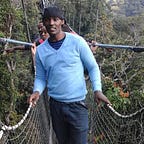Kandt House Museum
It takes about an hour to peruse through all exhibits at the Kandt House Museum but I was there for more than two hours. My guide, a young lady rocking a beautiful umushanana (traditional attire) had to wait patiently as I took my time reading every text, staring at every image and viewing every displayed object. While dealing with probably the slowest visitor she had ever ushered, she found herself answering a lot of questions and providing explanations concerning events that took place before her own grandfather was born.
The Kandt House Museum is the oldest splendour of modern architecture in Kigali. It was built in 1908 but still looks posh in 2018. I can’t imagine how imposing that castle was more than 100 years ago.
I got the knack of my first lesson before I started studying exhibits hanging on the walls. Kandt’s house at a glance is a revelation of how large the colonial governor lived. He built a mansion never seen in Rwanda during the first quarter of the 20th Century. Based on what I perceived from his portraits and the statue erected outside the building, the man popularly known as Bwana Mkubwa branded himself as the boss.
The representative of the German Emperor in Rwanda came from humble beginnings. Before setting foot on the African continent, seldom known Kandt worked as a psychiatrist in Bayreuth and Munich. Driven by his strong desire to explore Africa, Kandt studied the map of the continent European powers were scrambling for. He also made efforts to get acquainted with cultural aspects of different African societies. On top of that, he learnt Swahili in preparation for his East Africa expedition. He did all that while still in Germany.
Although his application for sponsorship from the German government was turned down, he still embarked on a journey of exploration using his own limited resources. He sailed to Zanzibar and eventually Bagamoyo before proceeding to Rwanda at the periphery of German East Africa. His biggest achievement as an explorer was the discovery of what he claimed to be the most important source of the Nile in Nyungwe forest.
Upon arrival, Richard Kandt didn’t provoke resistance from the local community. He approached Rwandans disguised as a friend rather than an agent of colonialism. Establishment of colonial rule in Rwanda was done through manipulation of the local power structures as opposed to military conquest, the game plan Kandt executed very well.
Four decades before Kandt’s arrival, a British explorer namely John Speke believed he had found the mysterious source of arguably the longest river in the world when he became the first European to see Lake Victoria. However, his differences with fellow explorer Richard Burton led to conflicting reports and an unsettled debate. Subsequent findings by Henry Stanley convinced the Royal Geographical Society (RGS) that Lake Victoria was indeed the source of the Nile. Stanley’s confirmation seemed to have solved the Nile puzzle until other explorers established a connection to Kagera River that flows into Lake Victoria from the highlands of Rwanda and Burundi. The new twist of discoveries called for further research and motivated the likes of Richard Kandt to dig deeper.
Kandt’s great discovery impressed German authorities and most likely had something to do with his 1907 political appointment. Before assuming his new role as a Resident Governor, he lived in a paltry hut at Ishangi peninsula in today’s Western Province.
Kandt’s choice of the land on which his Nyarugenge house was constructed is responsible for the location of the city of Kigali as we know it today. His name comes up whenever Kigali’s history is told. He is portrayed as a colonial administrator who was surprisingly in good terms with the Rwandan king and the local population. Some give him credit for long standing good bilateral relations between Rwanda and Germany. His house hosted the Museum of Natural History until its recent transformation into a colonial history exhibition, officially becoming the Kandt House Museum. Renaming this site of historical significance in his memory is a recognition rarely accorded to colonialists.
In his book titled Caput Nili, Richard Kandt gives a detailed account of his search for the source of the Nile. He was a courageous adventurer who endured a strenuous journey to the heart of what was known as the dark continent. He faced formidable challenges along the way but his resilient spirit and unshakable determination kept him going until he found what he was looking for.
The Kandt House Museum is a loaded pool of information exposing life as experienced before and during colonialism. Introduction of Christianity and the outbreak of World War I are also documented.
Natural history items have been moved to the Museum of Environment located in Karongi District but there is a baby crocodile and a collection of different species of snakes in the backyard. Those crawling reptiles scared the hell out of me. I knew it was time to leave the governor’s house when I started encountering crocodiles and snakes. At this point, the young guide in a beautiful umushanana didn’t have to wait patiently while being grilled with numerous questions.
The author is an adventurer based in Kigali, Rwanda. Feel free to email him your thoughts/tips.
Email: george@exposure.rw
